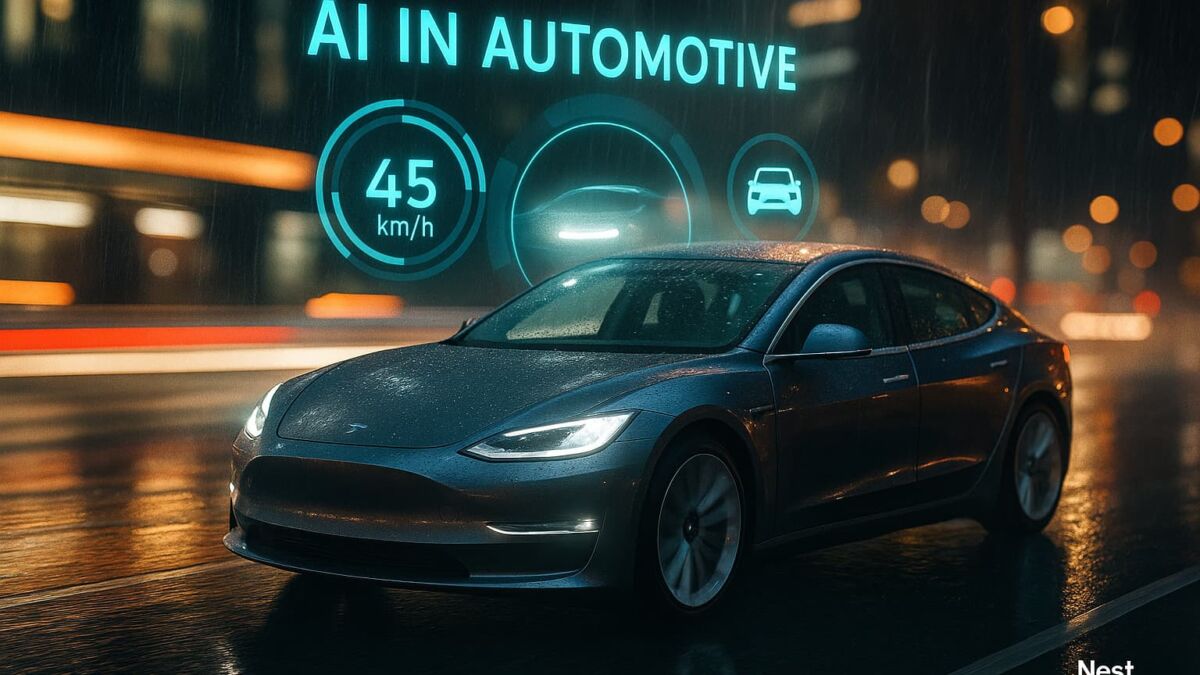AI in the automotive industry is moving from buzzwords to real outcomes. This complete guide shows what works, why it works, and how to build it safely for people, products, and cities.
Table of Contents
- Why AI in the Automotive Industry Matters Now
- From Hardware to Software: How We Got Here
- Design & Engineering: Generative, Simulation, Trade-offs
- Smart Manufacturing: Vision, Robotics, Quality
- Predictive Maintenance & Diagnostics
- Driver Assistance & Intelligent Safety
- In-Cabin Experience: Assistants, Comfort, Wellness
- Supply Chain & Logistics Optimization
- Edge AI + Cloud: Real-Time Architecture
- Cybersecurity, Privacy & Responsible AI
- KPIs & Scorecards That Prove Value
- Mini Case Studies
- Safe Rollouts: OTA, Canary, and Rollback
- Future Jobs & Skills
- Buyer’s Checklist for Leaders
- FAQs
- References
- Conclusion
- Glossary
- Back to Top
Why AI in the Automotive Industry Matters Now
Value is shifting from parts to software, data, and updates. The most useful “component” is the ability to improve continuously. When executed with care, AI in the automotive industry reduces defects, anticipates failures, protects drivers, and personalizes the cabin without being intrusive.
Trust is the line between delight and backlash. Winning teams pair explainable models, privacy-first data flows, and resilient safety practices. That is how AI in the automotive industry becomes helpful instead of noisy. On our site, related deep-dives include Generative AI in Business and Cloud Tools for Small Businesses which translate platform thinking into daily execution.
From Hardware to Software: How We Got Here
Automotive moved from many isolated ECUs to centralized compute and zonal architectures. This enabled secure over-the-air updates and continuous improvement. With that base, AI in the automotive industry now spans design, plant vision, predictive service, ADAS, in-cabin assistants, and connected supply chains. Outcomes: shorter design cycles, higher first-time-right assembly, safer roads, calmer commutes, and long-life customer relationships built on trust.
Design & Engineering: Generative, Simulation, Trade-offs
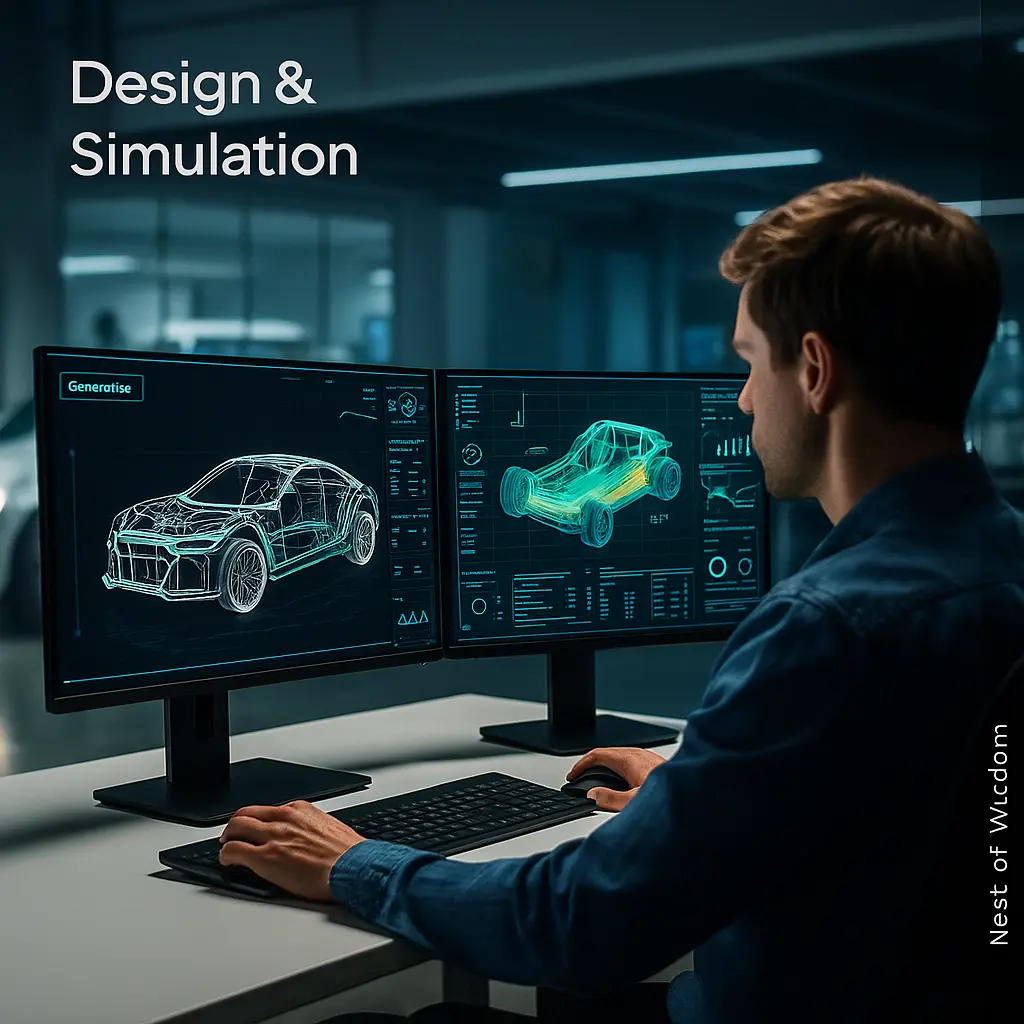

Design teams juggle safety, weight, cost, range, NVH, comfort, and sustainability. AI in the automotive industry helps by generating thousands of options that meet constraints and by using fast surrogate models for expensive physics. Engineers test bold ideas in hours instead of weeks.
- Generative design: propose structures that satisfy strength, stiffness, packaging, and crash zones.
- Simulation acceleration: ML-enhanced solvers approximate stress/strain, aerodynamics, and thermal behavior.
- Reinforcement learning: tune parameters for performance and manufacturability.
- Digital twins: validate behavior across roads, weather, and driver profiles before prototypes.
Bottom line: AI in the automotive industry compresses loops and improves trade-off quality with transparent engineering oversight.
Smart Manufacturing: Vision, Robotics, Quality
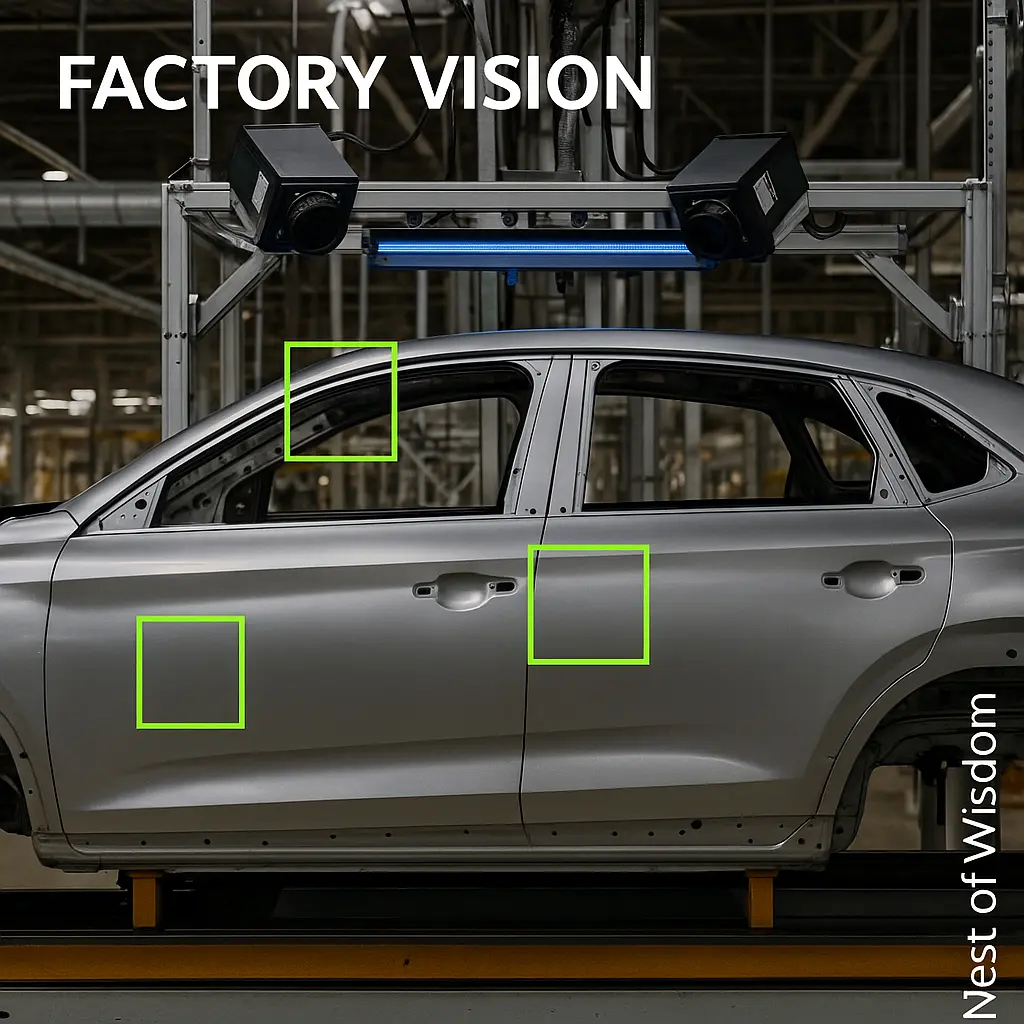

On the line, cameras and anomaly detectors catch surface defects, misalignments, and assembly gaps in real time. Vision-guided robots apply consistent force and placement. AI in the automotive industry turns noisy plant data into predictable quality gains.
- Quality vision: supervised and self-supervised models flag scratches, paint issues, weld anomalies.
- Human-robot collaboration: safety-rated sensors enable assistive robotics and reduce injuries.
- Yield optimization: feedback loops reveal systemic issues early to cut scrap and rework.
Result: safer plants, steadier output, and fewer warranty headaches.
Predictive Maintenance & Diagnostics
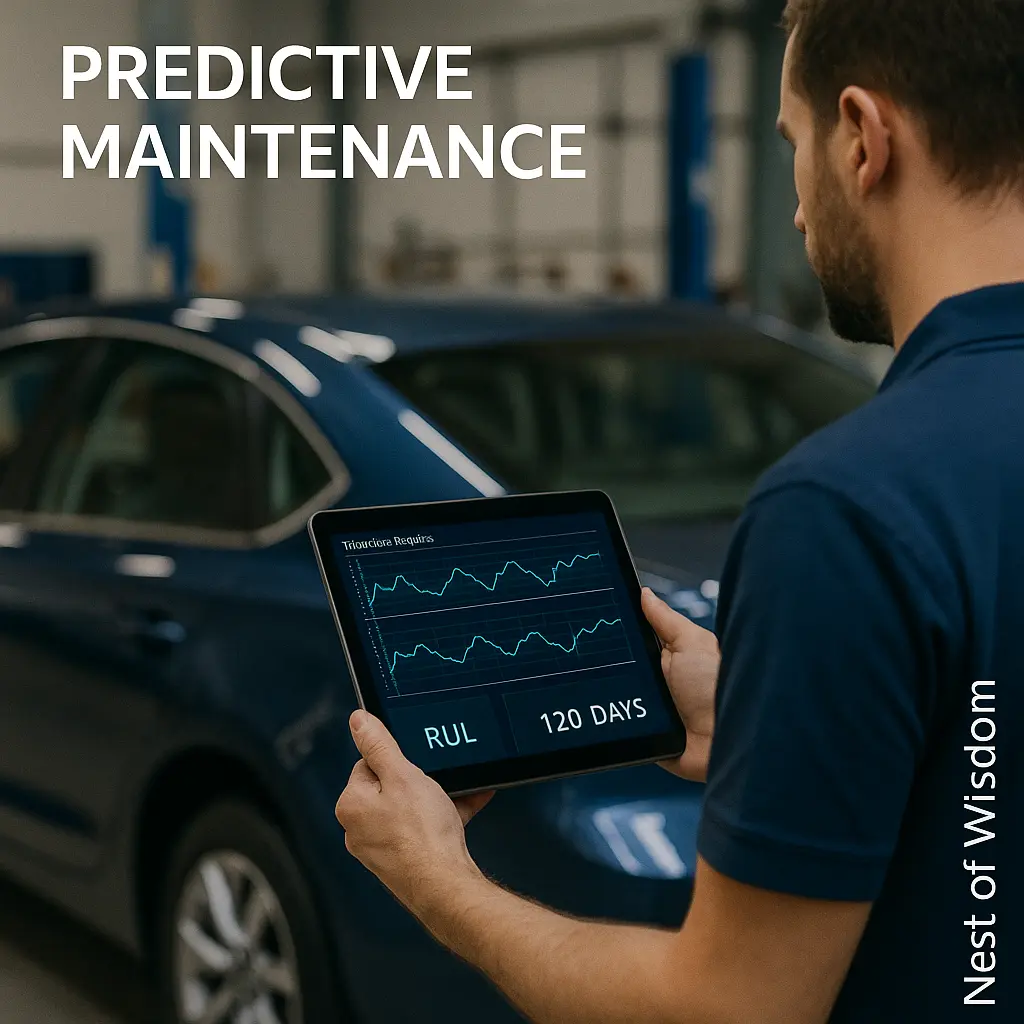

Vehicles emit rich telemetry: vibration, temperatures, voltages, duty cycles, and DTCs. With AI in the automotive industry, fleets move from fixed intervals to condition-based maintenance. Time-series models spot drift; gradient boosting and transformers find failure precursors; recommendations integrate with service scheduling. Drivers see fewer surprises. Fleets gain uptime. Finance teams see warranty cost fall. Privacy is preserved with edge preprocessing and anonymization.
Driver Assistance & Intelligent Safety
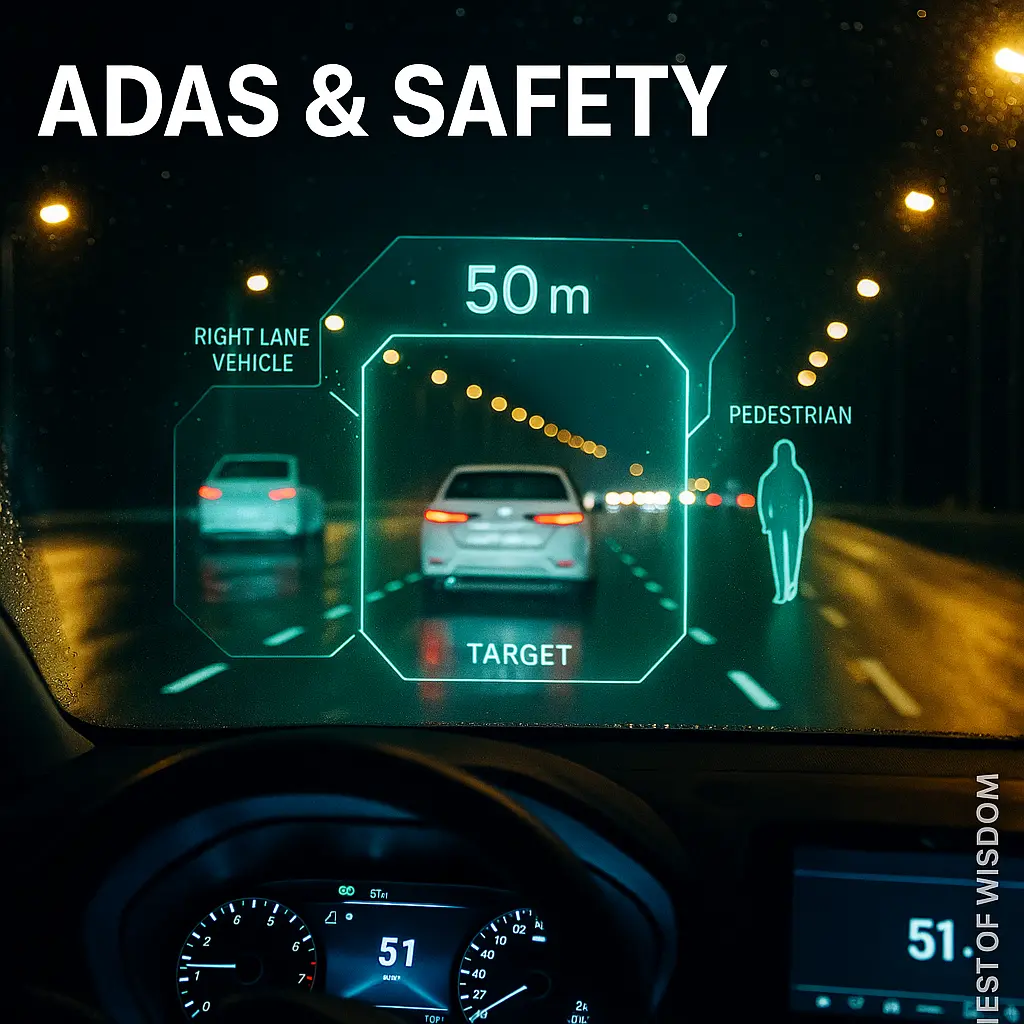

Assistance stacks fuse cameras, radar, and ultrasonics. Perception identifies lanes, vehicles, pedestrians, and signs. Planning proposes safe trajectories; control executes smoothly. Responsible AI in the automotive industry keeps the human in the loop with clear supervision and fail-safe behavior.
- Perception: multi-sensor fusion improves robustness in rain, glare, and night conditions.
- Driver monitoring: detects distraction or fatigue and nudges gently.
- Transparent UX: the car explains what it sees and intends to do.
Add a short safety explainer video here (official source) to satisfy “rich media.”
In-Cabin Experience: Assistants, Comfort, Wellness
Inside the cabin, assistants become copilots. Natural-language controls handle media, navigation, climate, and trip summaries. With consent, personalization learns seating, lighting, and music to lower stress. AI in the automotive industry improves accessibility with voice and multimodal controls and protects dignity with on-device processing for sensitive interactions.
Gentle prompts for breaks on long drives and ambient lighting that matches mood can reduce fatigue without distraction. For broader assistant patterns, see Generative AI in Business.
Supply Chain & Logistics Optimization
Automotive supply chains are huge and sensitive to shocks. AI in the automotive industry dampens bullwhip effects with demand forecasting and inventory optimization. Routing models balance cost, distance, time windows, and emissions. Simulation stress-tests plans so leaders prepare playbooks before disruption hits.
- Forecasting: blend history with exogenous signals and quantify uncertainty.
- Network design: decide where to buffer inventory and how to sequence suppliers.
- Resilience: run what-ifs to catch brittle links early.
Edge AI + Cloud: Real-Time Architecture
Driving decisions must run locally. Vehicles host accelerators and real-time environments. The cloud handles heavy training, fleet analytics, and staged rollouts. This handshake keeps AI in the automotive industry low-latency, updatable, and private.
Data Flow Snapshot
- Edge ingest: CAN/Ethernet signals land on an edge gateway; sensitive payloads are filtered.
- On-device AI: perception, planning, and driver monitoring run with deterministic timing.
- Aggregation: non-sensitive summaries batch to cloud with retention rules.
- Training: cloud trains new models; scenario libraries expand coverage.
- Safe rollout: canary, region gating, staged OTA, and rollback.
With this pattern, AI in the automotive industry stays responsive while learning from the fleet.
Cybersecurity, Privacy & Responsible AI
Connected, updatable vehicles demand defense-in-depth. Secure boot, signed binaries, encrypted comms, intrusion detection, and a software bill of materials are table stakes. New regulations require formal cybersecurity and software-update management systems, which shape how AI in the automotive industry is built and audited.
- Lifecycle security: develop-to-decommission coverage; patch pipelines and incident playbooks.
- Privacy by design: data minimization, on-device handling, anonymization, and strict access.
- Responsible AI: diverse datasets, scenario banks, adversarial testing, and human oversight.
KPIs & Scorecards That Prove Value
Leaders fund what they can measure. Tie AI in the automotive industry to clear KPIs and review them monthly.
- Design: simulation hours saved, prototype count reduction, mass vs. stiffness gains.
- Manufacturing: defect rate per 10k units, false-positive/negative rates, OEE uplift.
- Maintenance: mean time between failures, unplanned downtime, warranty cost per vehicle.
- ADAS: disengagement context, intervention clarity, driver compliance, post-update incident trends.
- In-cabin: task success, distraction metrics, opt-in rates for personalization.
- Supply chain: forecast error, stockouts, expedited freight spend, on-time-in-full.
- Security: patch latency, incident MTTD/MTTR, SBOM coverage.
Scorecards keep hype in check and prove that AI in the automotive industry delivers real value.
Mini Case Studies
Paint-Shop Vision: Surface Defects at Scale
A plant deploys high-res cameras over clear coats. Self-supervised pretraining plus a small labeled set catch micro-scratches and orange peel. QA focuses human attention on tough cases. False positives drop after active-learning rounds. Yield rises and rework falls. This is AI in the automotive industry that pays back in months, not years.
Cooling Pump RUL: Fix Before Failure
A fleet monitors a battery-pack cooling pump. Signals: vibration bands, current draw, temperature deltas, and PWM duty cycle. A hybrid model (gradient boosting + transformer features) assigns remaining useful life bands. Service schedules shift from mileage-based to condition-based. Roadside incidents drop; inventory shrinks; satisfaction climbs. Again, practical AI in the automotive industry.
Edge-Cloud Rollout: Safe Updates
An OEM stages a perception update. Canary to 0.5% in a mild region, checks real-world telemetry for regressions, then 5%, then 25%, then global. Rollback is one click. This staged OTA keeps AI in the automotive industry adaptive and accountable.
Seat Comfort Personalization: Subtle but Loved
A mid-size model uses on-device learning for lumbar and temperature preferences. It adapts to trip type and time of day. Because processing is local and opt-in, adoption stays high. Small wins like this make AI in the automotive industry feel human, not pushy.
Safe Rollouts: OTA, Canary, and Rollback
Updates are power and risk. Treat them with respect. A safe playbook keeps AI in the automotive industry stable.
- Eligibility gating: battery, storage, and environment checks before downloads.
- Staged rollout: canary cohorts, region gating, time-of-day limits.
- Shadow mode: run new perception alongside old, compare outputs before activation.
- Kill-switch and rollback: instant disable if incident thresholds are crossed.
- Post-update audit: analyze near-misses and publish notes in release logs.
Future Jobs & Skills
As AI in the automotive industry matures, roles evolve. The winners blend domain sense with data fluency and human-centered judgment.
- Applied ML Engineer (Auto): sensor fusion, time-series, embedded deployment, safety evaluation.
- Vehicle Data Engineer: edge pipelines, schema versioning, privacy filters, lakehouse design.
- AI Safety & Validation: simulation, scenario coverage, traceability, red-teaming.
- HMI/Conversation Designer: multimodal UX, accessibility, distraction minimization, transparency cues.
- Cybersecurity Engineer: secure OTA, key management, IDS, incident response.
- Reliability Analyst: RUL modeling, CBM strategies, fleet dashboards.
- AI Product Manager: safety-aware roadmaps, user research, trust metrics beyond clicks.
Buyer’s Checklist for Leaders
Use this fast filter when evaluating vendors and internal pitches for AI in the automotive industry.
- Proven metrics and error bars, not just demos.
- Scenario coverage against your weather, roads, and driver mix.
- SBOM, patch pipeline, and incident playbooks.
- On-device privacy for sensitive interactions.
- Accessible UX and clear driver supervision rules.
- Rollback plan and kill-switch tested in drills.
- Licensing that covers data lineage and retraining rights.
FAQs
What does AI in the automotive industry include today?
Design simulation, plant vision and robotics, predictive maintenance, driver assistance, in-cabin assistants, supply chain optimization, and secure edge-to-cloud analytics.
Is AI in the automotive industry safe for driver assistance?
It improves safety when built with multi-sensor redundancy, rigorous validation, clear supervision, and cybersecurity. Add transparent UX so drivers understand system status.
How does AI in the automotive industry protect privacy?
By collecting less, processing sensitive interactions on-device, anonymizing telemetry, enforcing strict access controls, and using short retention windows.
Which jobs grow with AI in the automotive industry?
Applied ML, data engineering, safety validation, HMI/voice design, cybersecurity, reliability analytics, and product roles that blend domain sense with data fluency.
References
- NHTSA: Driver Assistance Technologies
- UNECE WP.29 Overview and UN Regulations on Cybersecurity & Software Updates
- McKinsey: Winning the Automotive Software Development Race
Internal reads for platform thinking: Generative AI in Business and Cloud Tools for Small Businesses.
Conclusion
AI in the automotive industry is not a race to replace drivers. It is a commitment to cut risk, remove friction, and return attention to what matters. Leaders who pair engineering rigor with empathy will build products people invite into their lives and keep there.
Glossary
- CBM: Condition-Based Maintenance.
- ECU: Electronic Control Unit.
- OEE: Overall Equipment Effectiveness.
- OTA: Over-the-Air software update.
- RUL: Remaining Useful Life.
- SBOM: Software Bill of Materials.
Nest of Wisdom Insights is a dedicated editorial team focused on sharing timeless wisdom, natural healing remedies, spiritual practices, and practical life strategies. Our mission is to empower readers with trustworthy, well-researched guidance rooted in both Tamil culture and modern science.
இயற்கை வாழ்வு மற்றும் ஆன்மிகம் சார்ந்த அறிவு அனைவருக்கும் பயனளிக்க வேண்டும் என்பதே எங்கள் நோக்கம்.
- Nest of Wisdom Authorhttps://nestofwisdom.com/author/varakulangmail-com/
- Nest of Wisdom Authorhttps://nestofwisdom.com/author/varakulangmail-com/
- Nest of Wisdom Authorhttps://nestofwisdom.com/author/varakulangmail-com/
- Nest of Wisdom Authorhttps://nestofwisdom.com/author/varakulangmail-com/
Related posts
Today's pick
Recent Posts
- Internal Linking Strategy for Blogs: A Practical, Human-Centered Playbook
- AI in the Automotive Industry: A Practical, Human-Centered Guide
- Cloud Tools for Small Businesses and Freelancers: The Complete Guide
- Generative AI in Business: Real-World Use Cases, Benefits & Risks
- 7 Life-Changing Daily Habits for Weight Loss Without Dieting

